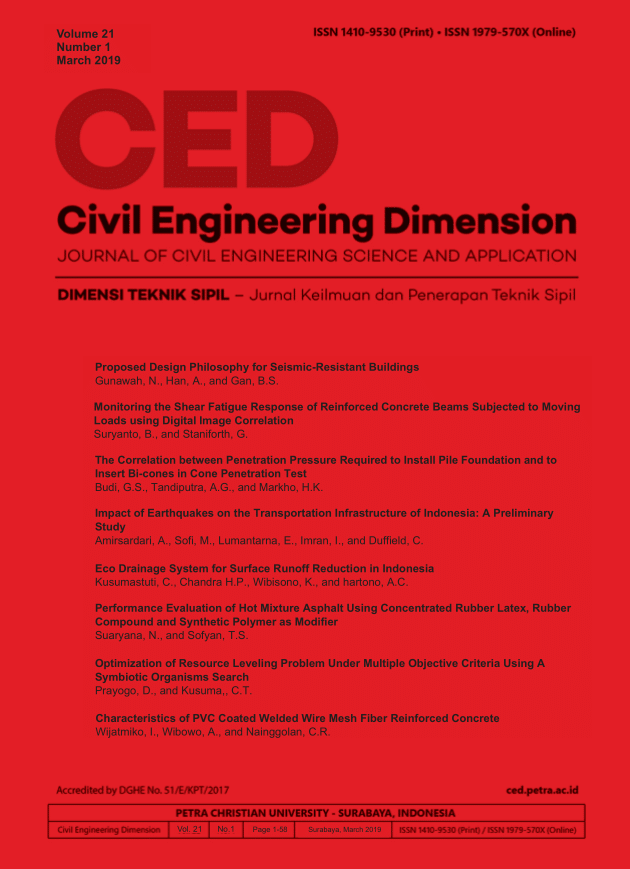Performance Evaluation of Hot Mixture Asphalt Using Concentrated Rubber Latex, Rubber Compound and Synthetic Polymer as Modifier
DOI:
https://doi.org/10.9744/ced.21.1.36-42Keywords:
Latex, modifier, polymer, performance, rubber compoundAbstract
Research on the utilization of natural rubber for Hot Mixture Asphalt as modifier has been widely carried out, and more intensively since 2016 due to the declining global natural rubber price. Further research conducted is the utilization of pre-vulcanized concentrated rubber latex and rubber compound added with antioxidants and treated through vulcanization process. This study experimentally evaluates the performance of Asphalt Concrete Wearing Course (ACWC) using natural rubber and synthetic polymer as modifier, compared to ACWC without modifier (only petroleum asphalt). The results show that the rubberized asphalt has higher index penetration value as well as higher elasticity compared to petroleum asphalt penetration grade 60, but lower than synthetic polymer modified asphalt. Similarly, the level of performance of rubberized asphalt mixtures, particularly resilient modulus, water resistance, deformation, and fatigue cracking, is between that of petroleum asphalt and synthetic polymer modified asphaltReferences
Indonesia Investments, Karet (alam). Available at https://www.indonesia-investments.com/id/bisnis/komoditas/karet/item185?. Accessed January 18, 2018
Ruggles Colin S, The Efficient Use of Environmentally-Friendly Natural Rubber Latex in Road Construction – Past, Present and the Future. Seminar “Rubber in Transport”, 2004. Available at https://www.revertex.com . Accessed July 10, 2018
Tuntiworawit, N., Lavavsiri, D., Phromsorn, C., The Modification of Asphalt with Natural Rubber Latex, Proceedings of the Eastern Asia Society for Transportation Studies, Vol. 5, 2005, pp. 679 - 694
Wen, Y., Wang, Y., Zhao, K., Sumalee, A, The Use of Natural Rubber Latex as a Renewable and Sustainable Modifier of Asphalt Binder, International Journal of Pavement Engineering, 2015, pp. 1-13
Vichitcholchai, N., Panmai, J., Na-Ranong, N., Modification of Asphalt Cement by Natural Rubber for Pavement Construction. Rubber Thai Journal 1, 2012, pp. 32-39. Available at https://www.rubberthai.com . Accessed July 9, 2018.
Okieimen, F. E., Akinlabi, A. K., Processing Characteristics and Physicomechanical Properties of Natural Rubber and Liquid Natural Rubber Blends, Journal of Applied Polymer Science. 85(5), 2002, pp. 1070-1076
Zborowski, A., Kaloush, K. E., Predictive Equation to Evaluate Thermal Fracture of Asphalt Rubber Mixtures, Road Materials and Pavement Design, 8(4). 2007, pp. 819-833
AASHTO T 245: 2014, Standard Method of Test for Resistance to Plastic Flow of Asphalt Mixture using Marshall Apparatus, American Association of State Highway and Transportation Officials, Washington, D.C., 2014.
AASHTO T 283: 2014, Resistance of Compacted Bituminous Mixture to Moisture Induced Damage for Super-pave, American Association of State Highway and Transportation Officials, Washington, D.C., 2014.
ASTM D 7369: 2011, Standard Test Method for Determining the Resilient Modulus of Bituminous Mixture, American Standard Testing and Material, Washington, D.C., 2011.
JRA, Manual for Design and Construction of Asphalt Pavement , Japan Road Association, Japan, 1980.
ASTM D 7369, Determining the Fatigue Life of Compacted Hot Mix Asphalt (HMA) Subjected to Repeated Flexural Bending, American Standard Testing and Material, Washington, D.C. , 2011.
SNI 8198, Spesifikasi Campuran Beraspal Panas Bergradasi Menerus (Laston), Badan Standarisasi Nasional, Jakarta, 2015.
Shell, The Shell Bitumen Handbook. Sixth edition, Shell, UK National, 2015.
Huang Y.H., Pavement Analysis and Design second edition, Prentice Hall, New Jersey, 2004.
Suaryana, N., Perfomance Evaluation of Stone Matrix Asphalt using Indonesian Natural Rock Asphalt as Stabilizer, International Journal of Pavement Research and Technology, Jhongli: Chinese Society of Pavement Engineering, 9(5), 2016, pp. 387-392.
National Cooperative Highway Research Program (NCHRP): 2004, Guide for Mechanistic-Empirical Design, Part 3 Chapter 3 Flexible Design, Transportation Research Board, Washington DC.
Yoder and Witczak, Principles of Pavement Design, John Wiley & Sons. Inc, New York, 1975.
Downloads
Published
How to Cite
Issue
Section
License
Authors who publish with this journal agree to the following terms:- Authors retain the copyright and publishing right, and grant the journal right of first publication with the work simultaneously licensed under a Creative Commons Attribution License that allows others to share the work with an acknowledgement of the work's authorship and initial publication in this journal.
- Authors are able to enter into separate, additional contractual arrangements for the non-exclusive distribution of the journal's published version of the work (e.g., post it to an institutional repository or publish it in a book), with an acknowledgement of its initial publication in this journal.
- Authors are permitted and encouraged to post their work online (e.g., in institutional repositories or on their website) followingthe publication of the article, as it can lead to productive exchanges, as well as earlier and greater citation of published work (See The Effect of Open Access).











